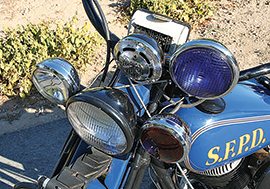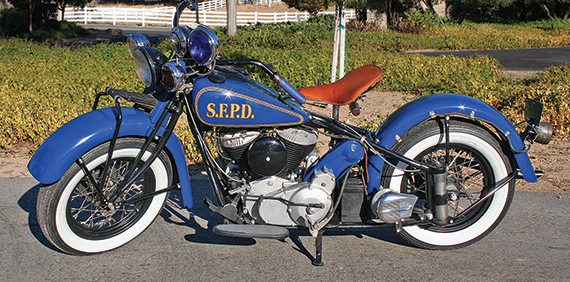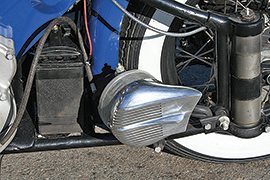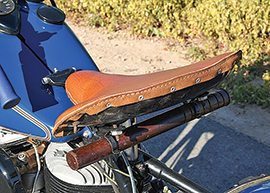
Wouldn’t the new Indian Motorcycle people just love it if the San Francisco Police Department ordered up some Indian police bikes? Just like it did a mere 70 years ago.
Back in 1945, this would have been the pride of the SFPD. World War II was coming to an end and American factories were already gearing up to satisfy civilian demands—and police forces were civilian, not military. The assembly line at the Indian factory in Springfield, Massachusetts, was turning out new bikes, and the demand was hot.

Not to be forgotten is the fact that during the financially depressed 1930s the main purchasers of motorcycles in the U.S. were government agencies, federal, state and city, mostly in the form of police bikes. And the competition between Indian and Harley was ferocious. One can only presume that skullduggery was often afoot, with both sides using undo influence as well as bribes to secure a contract. And Indian dealers were apparently quite successful in this slightly corrupt capitalism, as in 1940 the great majority of police bikes were Indians.
Then came World War II, and all efforts went to defeating the Axis, while hometown police departments made sure that what they had on hand was well-maintained, fixed when necessary, and riders were told to go easy on the tires. To help that notion along, in May of 1942, the national speed limit was set at 40 mph, later lowered to 35 mph.

This cop-sickle was essentially a 74-inch Indian Chief, which goes way back. Indian first used the Chief name in 1922 on a 61-inch side-valve (a.k.a. flathead) 42-degree V-twin engine, and a year later the 74-inch Big Chief came along. One unmistakable aspect was the leaf-spring front fork, first used in 1912, which may not have been lovely to look at but did an adequate job—for the time.
All sorts of modernizing followed over the next 17 years, with a front brake added, dry-sump recirculating oil (as opposed to the constant-loss system), and aluminum cylinder heads as an option instead of the iron ones. Primary drive seemed to take a step backward, going from helical gears to a four-row chain.
In 1940, the Chief saw major changes to the chassis and the design. Shock absorbers were seen at the rear axle, allowing a brief amount of travel in what was called the “double-action” spring frame. Both the top and the bottom of each shock had coiled springs, in effect dealing with compression and rebound. Indian’s ads aimed at police forces stated, “No matter how rough the road, the riding’s smooth on an Indian Spring Frame ‘Police Special’…better control, greater safety and less fatigue for the man in the saddle.”

They also had skirted fenders, with very big skirts, and the motorcycles were advertised as having “…their matchless sweeping beauty, graceful full-skirted fenders….” Which were often not well appreciated by the public. Many dealers mounted standard fenders to keep customers happy, and sent the skirts off to the crusher. Although now that is the image most people have of Indians, the big fenders. However, during the war those big fenders disappeared, replaced by abbreviated ones in order to save metal…less wasteful, as one scribe put it.

The Chief Police Special weighed in at 540 pounds stripped, but fully equipped with radio and all could be closer to 600. The engine had a bore of 3.25 inches, stroke of 4.44 inches (82.5 x 112.7mm for you metric guys), for a total of 73.62 cubic inches. Sporting a Linkert carburetor and a modest 5.5:1 compression ratio, the motor was reputed to put out close to 40 horsepower, with top speed in the neighborhood of 80 mph. Of course, the engine could be hopped up, and with special cams the Chief was said to exceed 100 mph. This was bolted into a steel cradle frame, with the 3-speed transmission bolted onto the crankcase. The wheelbase ran to 62 inches, with 4.50 x 18 tires and basic, skinny single-leading-shoe brakes fore and aft.
In 1941, Indian offered a free option of smaller, wider wheels, going from 18 to 16 inches, with a fat 5.00 tire. The debate about wheel size goes on to this day, but from 1944 on, all Chiefs came with 16-inch wheels.
Note the red and blue lights up front, and the spotlight. The friction-powered siren was down behind the left-side footboard, activated by pushing it against the tire. The radio equipment (very expensive back then) has been taken off this bike, except for the little rectangular Motorola receiver seen above the speedometer.

Note, too, the black gas and oil caps. Since most bikes were going to the military, and the military did not want shiny objects that might reflect the sun and be seen from an enemy airplane, black was the color of all caps. And material like chromium was important to the war effort.
Beware you heavy-footed miscreants in your Hudsons and Studebakers, the long arm of Johnny Law was reaching out. The left-hand throttle would allow a right-handed officer to pull out his sidearm and fire away.
In 1946 the new Chief, Model 346, appeared with a springer front end, called a “dual-spring front fork with hydraulic shock absorber,” which worked a good deal better than the previous leaf spring—and the aestheticists had no objection. The full fenders also returned.
We can speculate as to whether or not the current Indian company wants to get into the police-bike competition.
(This Retrospective article was published in the February 2015 issue of Rider magazine.)







